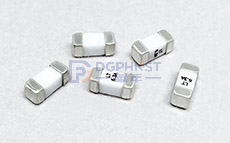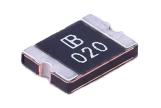Surface mount fuses are important components for electronic circuit protection, and can be classified into various types based on different dimensions such as working principle, packaging size, melting characteristics, and material technology. The following is a comprehensive classification and core features of patch fuses:
1、 Classified by working principle

Disposable patch fuse (blown type)
Characteristic: After melting, it needs to be replaced and cannot be restored.
Subdivision type:
Fast melting type: with fast response speed, suitable for circuits without surge current (such as semiconductor protection).
Slow melting type: Strong surge resistance, suitable for scenarios with startup surge currents such as motors and transformers.
Enhanced melting heat type: between fast and slow breaking, balancing surge resistance and economy.
Ultra fast melting type: made of silver material with outstanding current limiting ability, used for precision circuit protection.
Typical applications: power modules, consumer electronics, industrial equipment, etc.
Patch self-healing fuse (PPTC)
Features: Automatic recovery after overcurrent, reusable.
Subdivision type:
Conventional self recovery type: suitable for low-voltage scenarios such as USB interfaces, battery protection, etc.
High voltage self recovery type: capable of withstanding up to 150V600V, used for new energy vehicle BMS, industrial power supply, etc.
Low resistance self recovery type: With a normal resistance as low as 0.0004 Ω, it reduces energy consumption and is suitable for efficient scenarios such as fast charging and TWS earphones.
2、 Classified by packaging size

|Package model | Size (mm) | Typical current range | Applicable scenarios|
|||||
|0402 | 1.0 × 0.5 | 0.1A~0.75A (self recovery) | Micro devices (such as smartwatches)|
|0603 | 1.6 × 0.8 | 0.5A~6A (disposable) | Mobile phone, digital camera|
|1206 | 3.2 × 1.6 | 0.35A~40A (disposable) | Power module, display|
|1812 | 4.6 × 3.0 | 0.1A~2.6A (self recovery) | Vehicle electronic and industrial equipment|
|2920 | 7.3 × 5.0 | 0.3A~3.0A (self recovery) | High voltage circuit, communication base station|
3、 Classified by circuit breaker characteristics
Rapid response type
Suitable for stable circuits without surge current, such as precision instruments.
Slow/anti surge type
Resistant to pulse current, suitable for scenarios such as motors and incandescent lamps (such as the Satte 0603SD series).
Ultra fast response type
Silver containing alloy melt, used for semiconductor protection.
Double alloy slow type
Combining two alloy materials to enhance impact resistance.
4、 Classified by application scenario
Consumer Electronics
Model examples: 0603 quick break type (F series), 0402 self recovery type.
Scenario: Mobile fast charging, wireless headphones, digital cameras, etc.
Automotive Electronics
Model example: Automotive grade AECQ certified fuse (high temperature resistance, vibration resistance).
Scenario: BMS, on-board charger (OBC), etc.
Industry and Communication
Model examples: FRHV high voltage series (250VDC), Nano fuse (220VAC).
Scenario: 5G base station, industrial power module, energy storage system.
Medical equipment
Model example: Low resistance self recovery fuse (reduces energy consumption).
5、 Classified by materials and processes
Thin film patch fuse
Material: FR4 substrate+copper tin alloy fuse, working temperature ≤ 125 ℃.
Advantages: Low cost, suitable for conventional circuits.
Ceramic patch fuse
Material: Ceramic matrix, temperature resistance up to 150 ℃.
Advantages: High reliability, suitable for high temperature environments.
Thick film process fuse
Material: Silver alloy melt+ceramic substrate, with strong surge resistance (such as the Satte 0603SD series).
6、 Key parameters for selection
Rated current and voltage: It is necessary to cover the maximum operating value of the circuit, and FRHV series is preferred for high-voltage scenarios.
Circuit break time (I ² T value): Fast break type is suitable for precision protection, while slow break type is suitable for surge scenarios.
Environmental temperature: Choose ceramic or automotive grade fuses (such as FHT series) for high temperature scenarios.
Certification requirements: UL, RoHS, AECQ, etc. to ensure compliance.
The classification of patch fuses requires comprehensive consideration of working principles, packaging, melting characteristics, and scene requirements. For example, the 0603 fast break type is recommended for consumer electronics, the FRHV series is available for industrial high-voltage scenarios, and models certified by AECQ are required for automotive applications. When selecting specific models, it is recommended to refer to the manufacturer's specifications (such as Fuzhi, Sute, Lute Technology, etc.) and optimize them based on actual test data.
